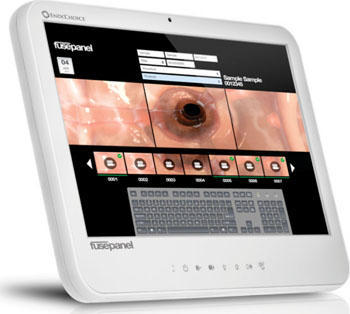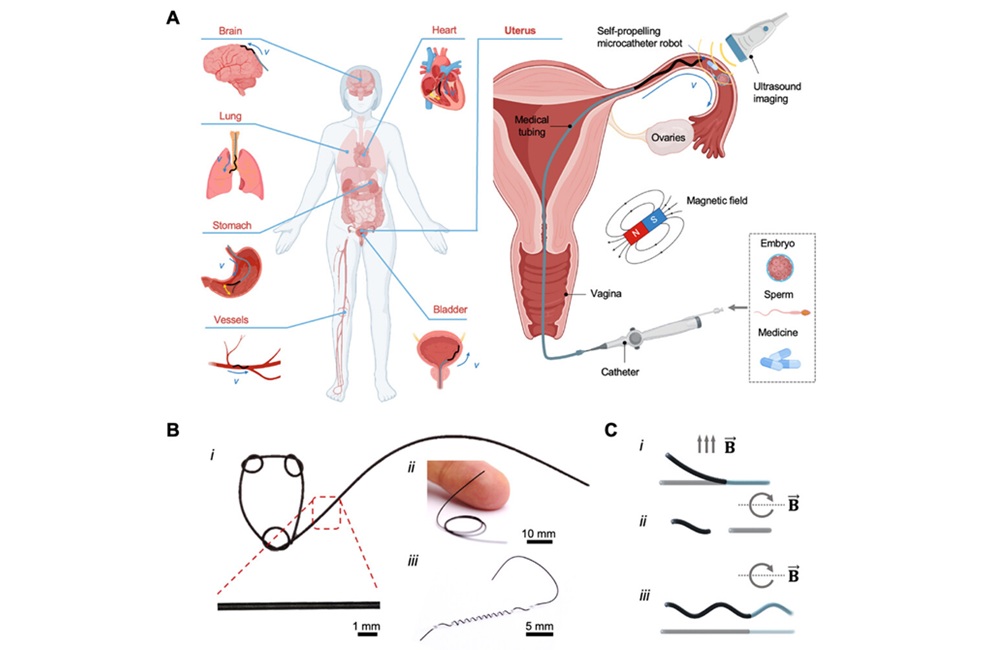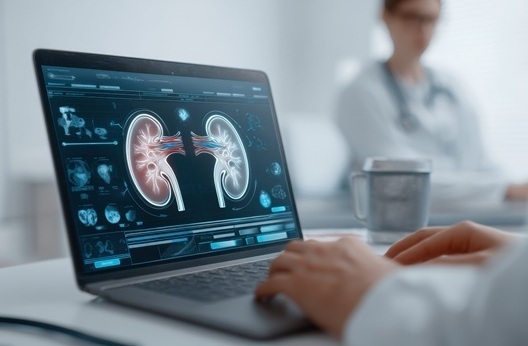Full Spectrum Endoscopy Detects Significantly More Polyps 
|
By HospiMedica International staff writers Posted on 31 Mar 2014 |

Image: The EndoCoice Fuse system control panel (Photo courtesy of Endochoice).
A pivotal comparison study shows that full spectrum endoscopy dramatically outperforms standard forward-viewing colonoscopy (SFV).
Researchers at the Rambam Health Care Campus (Haifa, Israel) conducted an international randomized trial in Israel, the Netherlands, and the USA involving 185 participants (18–70 years of age) referred for colorectal cancer screening, polyp surveillance, or diagnostic assessment. The patients underwent same-day, back-to-back tandem colonoscopy; 48% were randomly assigned to receive SFV first, and 52% to receive full-spectrum colonoscopy with the EndoChoice Fuse System colonoscope first. The primary endpoint was adenoma miss rates.
The results showed that by per-lesion analysis, the adenoma miss rate was significantly lower in patients in the full-spectrum endoscopy group (7%) than in those in the SFV procedure group (41%). Full-spectrum endoscopy missed 5 adenomas in 5 patients in whom an adenoma had already been detected with first-pass SFV; none of these missed adenomas that were advanced. SFV, on the other hand, missed 20 adenomas in 15 patients; of those, 3 were advanced adenomas. Five minor adverse events were reported including vomiting, diarrhoea, cystitis, gastroenteritis, and bleeding. The study was published in the March 2014 issue of the Lancet Oncology.
“As the gold standard for colorectal cancer screening, standard forward-viewing colonoscopy still misses a significant percentage of precancerous polyps due to inadequate visualization of the many folds and bends of the colon,” said lead author Ian Gralnek, MD, of the Rambam department of gastroenterology. “These study results confirm that Fuse is an important technological advancement in colorectal cancer screening that significantly improves visualization and has the potential to improve screening outcomes for many patients.”
“The results of this study support our greatest priority as physicians, which is to miss fewer precancerous polyps and improve the quality of our colonoscopies,” added Dr. Gralnek. “It is important for doctors and their patients to know the Fuse endoscopy platform is now available and has the ability to significantly increase adenoma detection rates.”
For the study the researchers used the EndoChoice (Atlanta, GA, USA) Fuse system, which uses three small cameras at the tip of a flexible gastrointestinal endoscope. By using three cameras, the system allows physicians to see nearly twice as much surface area as they can with traditional endoscopes, since the wider angles allow examination of folds that occur naturally in the colon and stomach anatomy, problem areas that can easily go undetected when using traditional one-camera endoscopes.
Related Links:
Rambam Health Care Campus
EndoChoice
Researchers at the Rambam Health Care Campus (Haifa, Israel) conducted an international randomized trial in Israel, the Netherlands, and the USA involving 185 participants (18–70 years of age) referred for colorectal cancer screening, polyp surveillance, or diagnostic assessment. The patients underwent same-day, back-to-back tandem colonoscopy; 48% were randomly assigned to receive SFV first, and 52% to receive full-spectrum colonoscopy with the EndoChoice Fuse System colonoscope first. The primary endpoint was adenoma miss rates.
The results showed that by per-lesion analysis, the adenoma miss rate was significantly lower in patients in the full-spectrum endoscopy group (7%) than in those in the SFV procedure group (41%). Full-spectrum endoscopy missed 5 adenomas in 5 patients in whom an adenoma had already been detected with first-pass SFV; none of these missed adenomas that were advanced. SFV, on the other hand, missed 20 adenomas in 15 patients; of those, 3 were advanced adenomas. Five minor adverse events were reported including vomiting, diarrhoea, cystitis, gastroenteritis, and bleeding. The study was published in the March 2014 issue of the Lancet Oncology.
“As the gold standard for colorectal cancer screening, standard forward-viewing colonoscopy still misses a significant percentage of precancerous polyps due to inadequate visualization of the many folds and bends of the colon,” said lead author Ian Gralnek, MD, of the Rambam department of gastroenterology. “These study results confirm that Fuse is an important technological advancement in colorectal cancer screening that significantly improves visualization and has the potential to improve screening outcomes for many patients.”
“The results of this study support our greatest priority as physicians, which is to miss fewer precancerous polyps and improve the quality of our colonoscopies,” added Dr. Gralnek. “It is important for doctors and their patients to know the Fuse endoscopy platform is now available and has the ability to significantly increase adenoma detection rates.”
For the study the researchers used the EndoChoice (Atlanta, GA, USA) Fuse system, which uses three small cameras at the tip of a flexible gastrointestinal endoscope. By using three cameras, the system allows physicians to see nearly twice as much surface area as they can with traditional endoscopes, since the wider angles allow examination of folds that occur naturally in the colon and stomach anatomy, problem areas that can easily go undetected when using traditional one-camera endoscopes.
Related Links:
Rambam Health Care Campus
EndoChoice
Latest Surgical Techniques News
- Laparoscopic Surgery Improves Outcomes for Severe Newborn Liver Disease
- Novel Endoscopy Technique Provides Access to Deep Lung Tumors
- New Study Findings Could Halve Number of Stent Procedures
- Breakthrough Surgical Device Redefines Hip Arthroscopy
- Automated System Enables Real-Time "Molecular Pathology" During Cancer Surgery
- Groundbreaking Procedure Combines New Treatments for Liver Tumors
- Ablation Reduces Stroke Risk Associated with Atrial Fibrillation
- Optical Tracking Method Identifies Target Areas in Robot-Assisted Neurosurgery
- General Anesthesia Improves Post-Surgery Outcomes for Acute Stroke Patients
- Drug-Coated Balloons Can Replace Stents Even in Larger Coronary Arteries
- Magnetic Kidney Stone Retrieval Device Outperforms Ureteroscopic Laser Lithotripsy
- Absorbable Skull Device Could Replace Traditional Metal Implants Used After Brain Surgery
- Magic Silicone Liquid Powered Robots Perform MIS in Narrow Cavities
- 'Lab-on-a-Scalpel' Provides Real-Time Surgical Insights for POC Diagnostics in OR
- Biodegradable Brain Implant Prevents Glioblastoma Recurrence
- Tiny 3D Printer Reconstructs Tissues During Vocal Cord Surgery
Channels
Critical Care
view channel
Miniature Non-Invasive Robotic Catheters to Improve Infertility Treatments
Minimally invasive procedures in reproductive and gynaecological medicine are often limited by the difficulty of navigating narrow, delicate anatomical pathways without damaging surrounding tissue.... Read more
Stick-On Patch Monitors Baby's Movements In Utero
Reduced or altered fetal movement is one of the most common reasons expectant parents seek urgent medical care, yet monitoring outside the hospital remains limited. Most pregnant individuals rely on self-counting... Read morePatient Care
view channel
Revolutionary Automatic IV-Line Flushing Device to Enhance Infusion Care
More than 80% of in-hospital patients receive intravenous (IV) therapy. Every dose of IV medicine delivered in a small volume (<250 mL) infusion bag should be followed by subsequent flushing to ensure... Read more
VR Training Tool Combats Contamination of Portable Medical Equipment
Healthcare-associated infections (HAIs) impact one in every 31 patients, cause nearly 100,000 deaths each year, and cost USD 28.4 billion in direct medical expenses. Notably, up to 75% of these infections... Read more
Portable Biosensor Platform to Reduce Hospital-Acquired Infections
Approximately 4 million patients in the European Union acquire healthcare-associated infections (HAIs) or nosocomial infections each year, with around 37,000 deaths directly resulting from these infections,... Read moreFirst-Of-Its-Kind Portable Germicidal Light Technology Disinfects High-Touch Clinical Surfaces in Seconds
Reducing healthcare-acquired infections (HAIs) remains a pressing issue within global healthcare systems. In the United States alone, 1.7 million patients contract HAIs annually, leading to approximately... Read moreHealth IT
view channel
EMR-Based Tool Predicts Graft Failure After Kidney Transplant
Kidney transplantation offers patients with end-stage kidney disease longer survival and better quality of life than dialysis, yet graft failure remains a major challenge. Although a successful transplant... Read more
Printable Molecule-Selective Nanoparticles Enable Mass Production of Wearable Biosensors
The future of medicine is likely to focus on the personalization of healthcare—understanding exactly what an individual requires and delivering the appropriate combination of nutrients, metabolites, and... Read moreBusiness
view channel
Philips and Masimo Partner to Advance Patient Monitoring Measurement Technologies
Royal Philips (Amsterdam, Netherlands) and Masimo (Irvine, California, USA) have renewed their multi-year strategic collaboration, combining Philips’ expertise in patient monitoring with Masimo’s noninvasive... Read more
B. Braun Acquires Digital Microsurgery Company True Digital Surgery
The high-end microsurgery market in neurosurgery, spine, and ENT is undergoing a significant transformation. Traditional analog microscopes are giving way to digital exoscopes, which provide improved visualization,... Read more
CMEF 2025 to Promote Holistic and High-Quality Development of Medical and Health Industry
The 92nd China International Medical Equipment Fair (CMEF 2025) Autumn Exhibition is scheduled to be held from September 26 to 29 at the China Import and Export Fair Complex (Canton Fair Complex) in Guangzhou.... Read more















